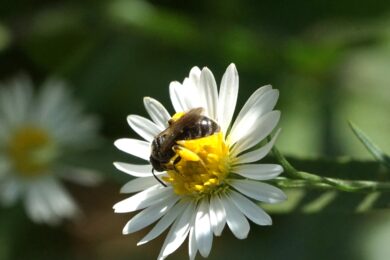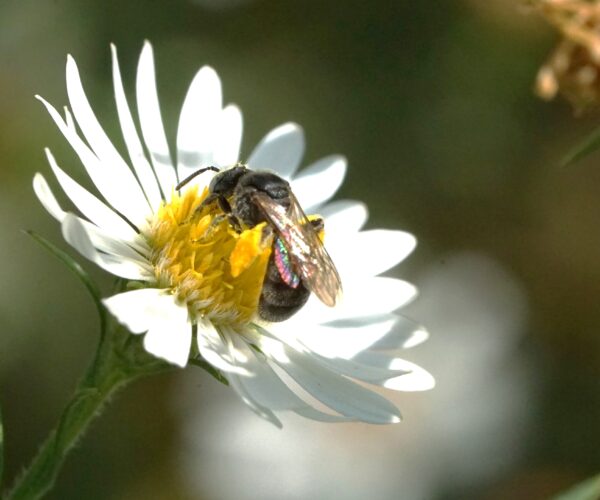
Protandrena compositarum
On October 22, with the insect season winding down, I was completing a final round of data collection for a three-year pollinator project BiodiversityWorks has been working on in collaboration with eight Vineyard farms and the Betsy and Jesse Fink Family Foundation. Aimed at studying the pollinators using habitat and floral resources on farms, the project seeks to develop easily replicated methods farms can use to boost pollinator diversity. The project has generated a wealth of information on what pollinators occur on farms and what flowers they prefer to visit.
On October 22, I was visiting the community garden section of Thimble Farm, in Vineyard Haven, where we established one of our eight plots to test pollinator response to a variety of (mostly native) flowers we planted. With a huge variety of flowers, both deliberately planted and naturally occurring, this community garden has emerged as one of the project’s most productive and interesting sites. Despite the late date, bees were still plentiful, and I managed to photograph 16 bees representing eight species. Most were familiar to me; but when I reviewed my photographs, I realized that two individuals I had photographed looked a bit strange.
Both had been females, loading up on pollen on the flowers of the native aster species Symphyotrichum pilosum. Black and small, at about seven millimeters in length, these bees had originally struck me as members of the vast and difficult genus Lasioglossum. But a number of details – the wing veins, the distribution of hair on the abdomen, the blocky head shape, how the bees were carrying pollen, and their oddly greenish eyes – looked wrong for that genus. When I entered photos of these bees into iNaturalist, the platform we use to compile most of the project’s data, iNat’s artificial intelligence suggested a genus I couldn’t even recall hearing of: Protandrena. I tagged bee ID expert Max McCarthy, who has helped me countless times with difficult identifications, and within a few minutes, he provided his verdict: Protandrena compositarum, an infrequently observed member of the “mining bee” family, Andrenidae.
I returned to Thimble Farm the next day and was able to collect a specimen of the mystery bee – once again, a female laden with pollen from the aster blossoms she was visiting. Using the identification key on the Discover Life website, I was able to confirm Max’s identification. Searching for previous Martha’s Vineyard records, I found none, and indeed, I could track down only one for the entire state of Massachusetts: a male beautifully photographed by my friend Molly Jacobson in Chesterfield, Massachusetts, at the end of this past August. A third New England record, from coastal Connecticut in early October 2024, also turned up in iNaturalist. Otherwise, this bee, which has been reported only sparsely, seems to range from the mid-Atlantic states west to Illinois, Missouri, and Arkansas. Most of the observations of this species in iNaturalist show the bee associating with asters and goldenrod, often small, white aster flowers such as the Symphyotrichum pilosum blossoms the species was visiting at Thimble Farm.
The dates of the three New England records I’ve found – all from the current year, 2024 – make me wonder if Protandrena compositarum is newly arrived in our region, moving northward, like so many other organisms, in response to climate change. It’s hard to believe the species could have been present but overlooked, then suddenly discovered in three widely separated New England locations. If so, the appearance already of multiple individuals on an offshore island such as Martha’s Vineyard is a bit surprising. In any event, whether newly arrived or just newly discovered, P. compositarum represents species number 202 on the still-growing Vineyard bee checklist.
Matt Pelikan is the director of the Martha’s Vineyard Atlas of Life project at BiodiversityWorks. While he appreciates living things of all kinds, bees are a particular favorite.


